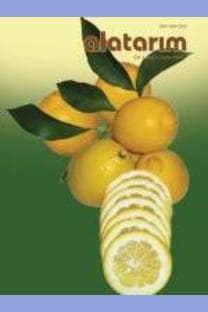Karpuz Melezlerinde Tohum Kabuk Rengi Kalıtımının Belirlenmesi
Bu çalışmada, Alata Bahçe Kültürleri Araştırma Enstitüsü Müdürlüğü karpuz gen havuzunda bulunan 11 adet hat ve bu hatlardan resiprokal olarak elde edilen melezlerin tohum renginin ve tohum iriliğinin kalıtım modeli ortaya konmuştur. Tohumlarda UPOV’a göre; büyüklük (çok küçük, küçük, orta, büyük, çok büyük), kabukta zemin rengi (beyaz, krem, yeşil, kırmızı, kızıl kahve, kahverengi, siyah), kabuğun ikincil rengi (yok, var), kabuğun ikincil renginin dağılım şekli (nokta, parça, nokta ve parça), zemin rengi ile ikincil rengin alan ilişkisi (küçük, orta, büyük), hilumda leke (yok, var), kenarda leke (yok, var) karakterleri gözlemlenmiştir. Yapılan gözlemlerde; 2 hat ve 5 melezde siyah renk, 3 hat ve 8 melezde kahverengi renk, 1 hatta kızıl kahve renk ve 1 hatta beyaz renk oluştuğu, 5 hat ve 9 melezde büyük tohum, 1 hat ve 4 melezde küçük tohum ve 1 hatta çok küçük tohum oluştuğu, 2 hat ve 4 melezde hilumda leke oluştuğu ve tüm hat ve melezlerde tohum kenarında leke oluşmadığı gözlemlenmiştir.
Determination of the Seed Coat Color Inheritance in Some Watermelon Hybrids
In this study, 11 lines in the watermelon gene pool of Alata Horticulture Research Institute Directorate and the inheritance model of the seed color and seed size of the hybrids obtained from these lines were revealed. According to UPOV; size (very small, small, medium, large, very large), ground color of testa (white, cream, green, red, red-brown, brown, black), secondary color of testa (absent, present), type of distribution of secondary color of testa (in dots only, in dots and in patches, in patches only), area of secondary color in relation to that of ground color (small, medium, large), patches at hilum (absent, present), patches at margin (absent, present), were examined for these parameters. Observations made; black color in 2 lines and 5 hybrids, brown color in 3 lines and 8 hybrids, one red-brown color and 1 line white color, big seeds in 5 lines and 9 hybrids, small seeds in 1 line and 4 hybrids and 1 line very small seeds, patches at hilum in 2 lines and 4 hybrids and no patches at margin of the seed.
___
- El-Hafez, A.A.A., Gaafer, A.K., Allam, A.M.M. 1981. Inheritance of Flesh Color, Seed Coat Cracks and Total Soluble Solids in Watermelon and Their Genetic Relations. Acta Agron. Acad. Hungaricae, 30: 82-86.
- FAO, 2017. FAO Web page.Year Production, Statistics, FAOSTAT, Watermelon Production, http://faostat.fao.org/default.asp×. Son erişim tarihi: 20.05.2019.
- Porter, D.R. 1937. Inheritance of Certain Fruit and Seed Characters in Watermelons. Hilgardia, 10: 489-509.
- Robinson, R.W., Decker-Walters, D.S., 1997. Cucurbits. CAB International, New York, NY, USA.
- Sarı, N., Tan, A., Yanmaz, R., Yetişir, H., Balkaya, A., Solmaz, I., Aykas, L., 2008. General Status of Cucurbit Genetic Resources in Turkey. Proceedings of the IXth EUCARPIA Meeting on Genetic and Breeding of Cucurbitaceae, 21-24 May 2008, Avignon-France, 21-32.
- Shimotsuma, M,, 1963. Cytogenetical Studies in the Genus Citrullus. VII. Inheritance of Several Characters in Watermelon. Japanese Journal of Breeding, 13:235-240.
- Tanaka, T., Wimol, S., Mizutani, T., 1995. Inheritance of Fruit Shape and Seed Size of Watermelon. School of Agriculture, Kyusyu Tokai University, Aso-gun, Kumamoto, 869-14.
- Wehner, T.C., 2008a. Watermelon In: Prohens J. and Nuez F. (eds.) Handbook of Plant Breeding; Vegetables I: Asteraceae, Brassicaceae, Chenopodiaceae and Cucurbitaceae. Springer Science Business LLC, New York, NY, 381-418.
- Wehner, T.C., 2008b. Overview of the Genes of Watermelon, Proc. Cucurbitaceae 2008 EUCARPIA Meeting, p. 79-89 (ed. M. Pitrat).
- Zhang, J., 1996b. Breeding and Production of Watermelon for Edible Seed in China. Cucurbit Genetics Cooperative Report, 19:66-67.
- ISSN: 1304-2653
- Başlangıç: 2015
- Yayıncı: Alata Bahçe Kültürleri Araştırma Enstitüsü
Sayıdaki Diğer Makaleler
Senem UĞUR, Yeşim Yalçın MENDİ
Kurt Üzümü'nün (Lycium barbarum L.) Konya Ekolojik Şartlarında Adaptasyonu Üzerine Bir Araştırma
Minimum İşlenmiş ‘Katırbaşı’ Nar Çeşidinin Soğukta Muhafazası
Elif ÇANDIR, AHMET ERHAN ÖZDEMİR, Tugay GÖV, Aslıhan KANAK, Huriye ÖZÇELİK
Karpuz Melezlerinde Tohum Kabuk Rengi Kalıtımının Belirlenmesi
Süleyman YALÇIN, Nebahat SARI, İlknur SOLMAZ
Celil TOPLU, AHMET ERHAN ÖZDEMİR, Elif ÇANDIR, ERCAN YILDIZ
A Research on Adaptation of Goji Berry (Lycium barbarum L.) in the Konya Conditions
Şenay KARABIYIK, Ahmet Burak ÇAĞLAR, Nesrin KARATAŞ, Sinan ETİ
